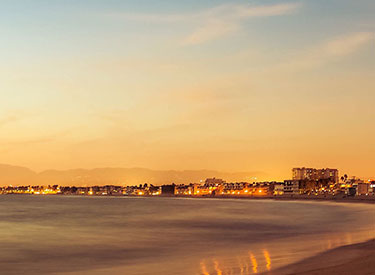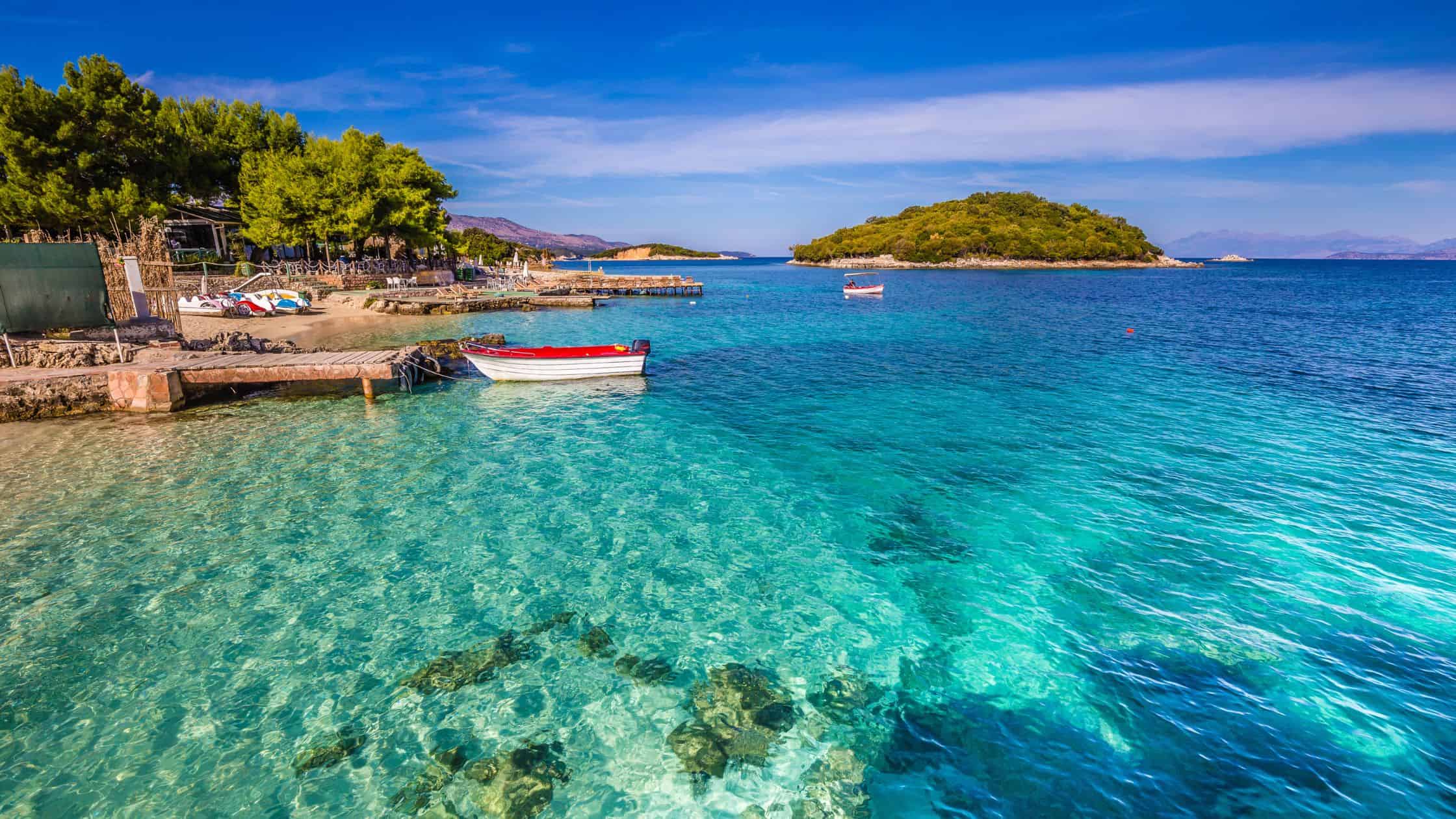


Albania is still one of Europe’s best kept secrets, although its pristine beaches, rugged mountains, ancient ruins and vibrant cities make it one of our favourite up-and-coming holiday destinations. Our handy guide to visiting Albania is filled with advice and inspiration, must-do experiences and our favourite hidden gems.
Known as Shqipëria in the Albanian language (Shqip), Albania is tucked between Montenegro and Greece on the Balkan Peninsula, with Kosovo and North Macedonia forming its eastern, landward borders. Its western boundary is formed by the sparkling waters of the Adriatic Sea, where the Albanian Riviera boasts some of Europe’s most spectacular beaches. Albania’s capital, Tiranë (Tirana), is unique as both one of the wettest and one of the sunniest cities in Europe. You’ll find a colourful blend of Ottoman, Italian, and Soviet influences, bustling cafés and rich history, with the natural wonders of the Skanderbeg mountain range almost on the city’s doorstep.
You can fly directly to Tiranë from many European countries, or travel by bus from Athens, Thessaloniki and Macedonia. You can also catch a ferry from Bari in southern Italy to Durrës, which is located on the coast around 40 kilometres from Tiranë. Ferries also depart regularly from the island of Corfu (Greece) to the picturesque southern coastal resort of Sarandë.
The network of mini-buses (known as furgon) that connect Albania’s main towns and cities are a cost-effective and fun way to explore the country while connecting with the locals – as long as you are prepared for their somewhat unreliable nature. If you prefer to travel by rental car, be aware that you should be a confident driver to tackle the Albanians’ sometimes-chaotic driving style.
Alternatively, your personal travel manager can help you choose a guided tour that will showcase the best highlights and hidden gems.
From June to August, the warm, Mediterranean climate means hot sunny weather that is ideal for lazing on Albania’s beautiful beaches or hiking in Albanian Alps – as long as you don’t mind sharing all that beautiful scenery with the peak season masses. Many travellers prefer to visit during the shoulder season months of May, September and October, when the weather remains warm and settled but there are smaller crowds.
Tirana’s Ish-Blloku neighbourhood was once the domain of Albania’s communist party elites (the name translates as Ex Block). These days, Blloku, as it is commonly known, is now one of the city’s most vibrant areas, packed with boutiques, restaurants and bars.
Find yourself a table at an outdoor café and spend a few hours watching the world go by, while indulging in delicious Albanian food: maybe a flaky Byrek pastry or delicate slice of Trileçe cake. Pro tip: for the best views in the city, ride the cable car ride to the summit of Mt Dajti.
Also known as Bregu, this lovely stretch of coastline is a laid-back alternative to Croatia, Montenegro and Greece and is set along a pristine expanse of the Ionian Sea. You can base yourself in the historic town of Sarandë and explore the local beaches, take a day trip to the Islets of Ksamil and explore the ancient ruins of Butrint.
It’s well worth venturing away from the coast to explore Albania’s mountainous interior and historic villages. Berat is known as the “City of a Thousand Windows” for the distinctive Ottoman architectural style of its whitewashed houses and the ancient ruins of its hilltop castle and mosques.
Gjirokastër, known as the “Stone City,” is one of Albania’s most beautiful and historically rich destinations, where you’ll find stone roofed houses, cobbled streets and the ruins of a twelfth-century castle. It’s only a short drive from here to the brilliant blue water of famous Blue Eye Spring.
Also known as the Albanian Alps, the Accursed Mountains extend across northern Albania and into Kosovo and Montenegro. Despite the ominous name, you’ll find some of the most breathtaking hiking trails in Europe in this remote and rugged region. dramatic peaks, deep valleys, and traditional villages.
It’s possible to complete the entire trek between Theth and Valbona Pass in a single day, but we recommend extending your time to explore more of spectacular Theth National Park, staying at one of the local family-run guesthouses and soaking up the spectacular scenery.
One of our favourite Albanian road trips starts in Himarë, where you’re treated to breathtaking coastal scenery before climbing over the Llogara Pass. After conquering the Ceraunian (Thunderbolt) Mountains, you’ll descend to the coast, finishing at the beach resort town of Orikum.
Currency – the official currency in Albania is the Albanian lek (plural: lekë, subunit: qindarkë, symbol: L); there are 100 qindarka in one lek. As of March 2025, one Australian dollar is worth approximately 57 lek. Credit cards are widely accepted in the main centres, but it’s helpful to carry some local currency for smaller transactions.
Time zone – between the end of March and the end of October, Albania is on Central European Summer Time (UTC+2), which is nine hours behind Australian Eastern Standard Time (UTC+10). Between November and March, Central European Time (UTC+1) applies.
Wi-Fi coverage/SIM cards – check with your telco provider about international roaming availability and pricing in Albania, or purchase a pre-paid travel SIM to use during your holiday. As one of the most mountainous countries in Europe, coverage can be patchy in more remote areas.
Passport and visa information – travellers with Australian passports can enter Albania as visitors for up to 90 days without requiring a visa. Albania is not part of the Schengen Area that permits border-free travel within 27 member countries for up to 90 days, which means your time in Albania is separate – handy if you’re looking to extend your European holiday beyond 90 days. Be sure to check Smartraveller or ask your personal travel manager for the most up-to-date information.
Safety – Albania is considered a relatively safe destination to visit if you take sensible precautions. Be aware of your surroundings, avoid isolated areas at night, and protect your belongings against pickpocketing. If you’re planning to spend time exploring the Albanian Alps, consider engaging the services of a local expert guide.
Language – English is quite widely spoken throughout Albania, especially in the main tourist areas, although it’s always helpful to learn a handful of basic Albanian phrases. The Albanian people have a reputation for being warm and hospitable, and they’re sure to appreciate your enthusiastic attempt to greet them with a cheerful “tungjatjeta.”
Albania’s charm lies in its authenticity and unspoiled beauty, its sun-drenched beaches and rugged mountain trails, its rich history and welcoming locals. If you’re looking to experience its fabulous mix of adventure, culture and spectacular scenery, talk to your personal travel manager today – before the rest of the world catches on to our little secret.